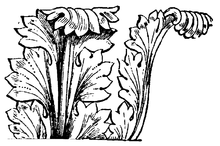Acanthus (ornament)

Akanthus (ending in Latin ) or Akanthos ( ancient Greek ὁ ἄκανθος ho akanthos "the thorny"), often also acanthus work , is the archaeological-art-historical term for the type of ornament that takes up the shape of the leaves of the plant genus of the same name in a stylized form.
Nature as a model: the acanthus leaf
The thistle-like acanthus leaf is a recurring motif in ornamentation. A row of acanthus leaves form an acanthus frieze . Acanthus leaves arranged symmetrically in a circle form an acanthus rosette . A tendril composed of acanthus leaves is called an acanthus tendril . This is a free artistic invention, since the natural acanthus does not grow any tendrils, just like flowers or goblets, which can be integrated into the representation.
History and types of occurrence
The acanthus ornament is still used today as an ornament. The forms of representation vary depending on the style epoch. The earliest evidence comes from the 5th century BC. Chr .: The acanthus leaf is a characteristic element of the Corinthian capitals .
It flourished again in baroque ornamentation . However, the literature speaks of 16 to the 18th century of acanthus only in connection with capitals and used in other forms of the corresponding Ornaments the concept foliage or Lauber . In 18th century France - especially during the Régence - the floral form was often combined with bandwork, a surface ornament in which the tendrils were replaced by lines decorated with flowers. This gave rise to the collective term foliage and banding .
Acanthus decorations can be found in architecture on columns, ceilings and other building parts, but also as tendril decoration ( foliage or foliage ) in book illumination.
There are acanthus altars in Bohemia and in the Upper Palatinate - for example in the churches of Auerbach , Hemau , Reuth , Poppenreuth and Thumsenreuth . The rampant gilded tendrils frame each picture and figure motifs. In contrast to many other altars , this creates a very flat overall impression.
An early form of foliage-shaped ornamentation can be found in Bamberg Cathedral on the base of the Bamberg Rider , which was created in the first half of the 13th century. A special feature is the huge leaf under the horse's front hooves, from which a human face emerges as a leaf mask .
See also → foliage .
The acanthus altar of the Catholic Church of St. Katharina in Reuth is considered to be the work of Johann Christoph Windisch .
Fourteen helper altar in the Catholic parish church of Thumsenreuth, built in 1935 . The youngest acanthus altar in the Upper Palatinate is the work of Sigmund Windisch .
Pulpit in St. Nikolai Church in Berlin-Spandau with acanthus carvings, created by an unknown master in the late 17th century.
In modern times, ornament was also often used on furniture, in interior decoration, on silver work, and as an ornamental motif on weapons. Corresponding forms are also used for badges of rank up to the present day.
Acanthus on porcelain
The sculptor and modeller Dominik Auliczek developed in the years 1792 to 1795 for the Bavarian Elector Karl Theodor to the taste of the early classicism an absolutely new type of service in the Louis XVI style. For the first time in the history of European porcelain manufacture, the pieces from the Perl service were not round, but rather twelve-sided . Individual parts that are particularly emphasized in their function, such as cups, tureens, serving bowls, are also decorated with three-dimensional acantus. This service was reserved for the Wittelsbach company until the beginning of the 20th century . Since then the children of King Ludwig III. and Archduchess Marie Therese had it made in 1918 as a present for their parents' golden wedding anniversary, it is also known as the Bavarian Royal Service . It bears the name Perl because of the fact that each object is surrounded by a fine rod of pearl .
Individual evidence
- ^ Meyer, Fr. S .: Handbook of ornamentation . 8th edition. Seemann, Leipzig 1911, p. 50 , urn : nbn: de: gbv: wim2-g-2252141 .
- ↑ Doris Oltrogge, Solange Michon and Robert Fuchs: Laubwerk - To the text tradition of a manual for illuminators from the 15th century. In: Würzburger medical historical reports 7, 1989, pp. 179–213; here: pp. 180 and 183
- ↑ Perl. Website of the Porzellanmanufaktur Nymphenburg , accessed on April 27, 2017.
literature
- Günther Irmscher: Akanthus: To the history of the ornament form. In: Baroque reports. Vol. 26/27, 2000, pp. 461-532.
- Alois Riegl : Questions of style: Foundations for a history of ornamentation. Berlin 1893. (Reprint 1985)
- L'Acanthe dans la sculpture monumentale de l'Antiquité à la Renaissance : [actes du colloque tenu du 1er on October 5, 1990 à la Sorbonne]. Paris 1993. ISBN 2-7355-0280-5 ; ISBN 2-85944-240-5 .
- Loretta Vandi: La trasformazione del motivo dell'acanto dall'antichità al XV secolo: ricerche di teoria e storia dell'ornamento. Bern 2002, ISBN 3-906767-76-0 .
- Franz Sales Meyer : Handbook of ornamentation. Tosa, Vienna 2002, ISBN 3-85492-638-3 , pp. 46–51. (Reprint of the 12th edition, Leipzig 1927).
Web links
Acanthus motif on English wallpaper from 1875, design: William Morris .
Akanthusmotiv as weapons Decorations: design for the hand guard of a kidney dagger by Hans Holbein the Younger , 1536-38.








